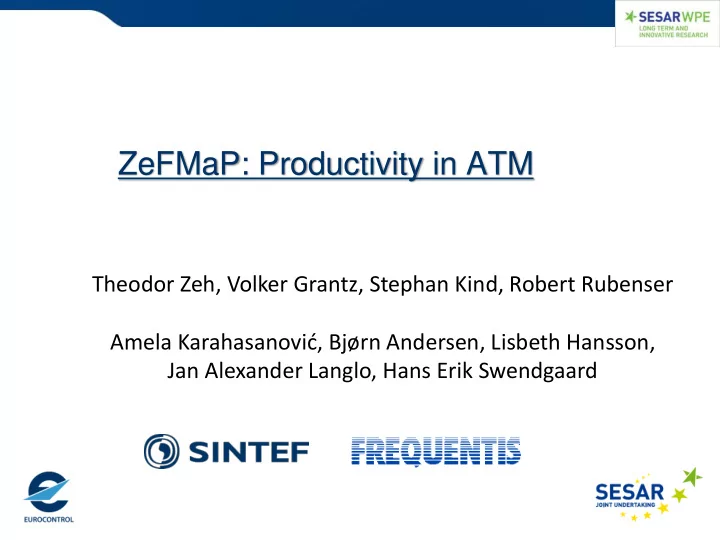

ZeFMaP: Productivity in ATM Theodor Zeh, Volker Grantz, Stephan Kind, Robert Rubenser Amela Karahasanović, Bjørn Andersen, Lisbeth Hansson, Jan Alexander Langlo, Hans Erik Swendgaard
Zero Failure process at Maximum Productivity in Safety Critical Environment What can we learn from Mass Production Processes?
The Hypothesis • Applying processes from mass production improves productivity and safety in ATM Systems. • Assumptions • An ATM Control Room is a sociotechnical system • An ATM Control Room is producing “something” • Main Questions • Can ATM be seen as production process? • Can the production be divided into value adding production steps? • Which process tools fit best?
Basics: Today's situation in Mass Production • Continuous Improvement Processes • Part of the philosophy of mass production • Has its origin in automotive mass production • Productivity combined with Zero Defect Policy • Decisions • are analysed with impact on the overall production output • are weighed in several “quality” steps
Basics: Today's situation in ATM • Continuous Improvement Processes • not seen in ATM business („production“) process • if then focussed on error prevention • Decisions • are seen isolated without of cross impact analyses (on the overall System). • are “right” (safe) or “wrong” (unsafe)
Basics: Sociotechnical System Sociotechnical System Technical Part Social Part - Production Input - Team Members - Automation Tools / Machines - Qualification and Training - Rooms / Building - Human Needs System Purpose - Production Output - System Maintenance - System Regulation
“ATM Mass Production” • What do we produce in ATM? • Safe Airmiles? • Safe starts and landings? • To be elaborated further together with KPIs • …
ZeFMaP - Safety Critical Mass Production „ Production Process“ (Value Adding) Domain Know How: Workflow Analyses Business Blue Printing Improvement Usability Engineering: Optimized Man/Machine Symbioses HF Safety: Decision Points -> all possible decisions: xFMEA Analyses HF Productivity: x6sigma Optimisation Loop „KVP“ Production Step 1 Production Step 2 Production Step 3 Production Step n
What is the right tool to improve productivity in ATM? Process modelling Problem solving Toyota Production System approach Load analysis … ?
Process modelling • Business Process Modeling (BPM) is the activity of representing processes of an enterprise, so that the current process may be analyzed and improved Other PCH Competing Health Care Local Public Social PCH Hospitals Hospitals Authorities Community Services Strong, Share Follow Find place, local Find place, profits, patients standards no threat provider no scandals Close cooperation Primary Care Take referrals Physicians seriously Different Local service Patient Groups Continued business, acceptable terms Suppliers Local Media Access to news Ambulance Services Handle emergency Secure, good Good working cases jobs conditions Hospital Volunteers Employees Stakeholder map for a Norwegian hospital
Customer submits Start complaint Adequate No Request further information information and documenting the documentation matter? Yes Receive documentation Conduct investigation Basic flowchart for a customer complaint process
Load Analysis/Bottlenecks • An organization consists of a system for transforming input to products or services • Everything that is used in this transformation process are resources, e.g., machines, storage space, people, • All such resources can be classified as either bottlenecks or non-bottlenecks. • A bottleneck is defined as: “ . . . a point in the transformation process that limits the flow the process can output. ”
How to proceed? • Perform analytical evaluation of existing approaches, methods and tools • Adapt the methods and tools to ATM domain • Apply them on TWR process in several iterations • Some challenges: • Barrier against seeing 'a big picture' • Conflicts between lean principles and safety • Inner drive in the organisation is important
How to validate our claims? • Hamburg Airport Scenario • Sufficient complexity to require higher automation tools • Simple enough to analyse it with production methods • Simulated with real peak hour traffic scenario from the past • University of Salzburg Simulator • Airport seen as black box • Inbound and outbound traffic life scenario from past peak hour
• KPI comparison with and without ZeFMaP • Definition of KPIs (ATM KPIs, others - team performance indicators…) • Baseline simulation run without ZeFMaP help • Up to 3 runs with (offline) ZaFMaP optimisation of decisions • Expectations • Improvement of productivity KPIs (punctuality, time to runway, time to gate) especially in high traffic load • Improvements will continue to a lesser extend with each iteration • Acceptance (satisfaction) by air traffic controllers will be equal or slightly improved • Follow up projects
Thank you for your attention! Questions? Suggestions? Contacts: Theodor.Zeh@frequentis.com Amela@sintef.no
Recommend
More recommend